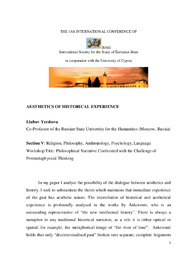Aesthetics of historical experience
| dc.contributor.author | Yershova, Liubov | en |
| dc.contributor.editor | Papastephanou, Marianna | en |
| dc.contributor.editor | Gregoriou, Zelia | en |
| dc.contributor.editor | Koutselini, Mary | en |
| dc.contributor.editor | Zembylas, Michalinos | en |
| dc.creator | Yershova, Liubov | en |
| dc.date.accessioned | 2013-05-21T06:50:16Z | |
| dc.date.available | 2013-05-21T06:50:16Z | |
| dc.date.issued | 2012-07 | |
| dc.identifier.uri | http://gnosis.library.ucy.ac.cy/handle/7/64919 | |
| dc.identifier.uri | http://hdl.handle.net/10797/6476 | |
| dc.description.abstract | In my paper I analyse the possibility of the dialogue between aesthetics and history. I seek to substantiate the thesis which maintains that immediate experience of the past has aesthetic nature. The interrelation of historical and aesthetical experience is profoundly analysed in the works by Ankersmit, who is an outstanding representative of �the new intellectual history�. There is always a metaphor in any traditional historical narration, as a rule it is either optical or spatial, for example, the metaphorical image of �the river of time�. Ankersmit holds that only �decontextualised past� broken into separate, complete fragments can be the real object of the historical experience. An event is a local structuralised being, whole process consisting of the beginning, culmination and completion. An event is born out of aesthetic experience. | en |
| dc.language.iso | eng | en |
| dc.rights | info:eu-repo/semantics/openAccess | en |
| dc.rights | Open Access | en |
| dc.subject | Aesthetics | en |
| dc.subject | Sublime | en |
| dc.subject | Nostalgia | en |
| dc.subject | Historical experience | en |
| dc.subject | Postmodernism | en |
| dc.title | Aesthetics of historical experience | en |
| dc.type | info:eu-repo/semantics/conferenceObject | en |
Files in this item
This item appears in the following Collection(s)
-
ISSEI - International Society for the Study of European Ideas [129]
13th ISSEI International Conference, University of Cyprus, July 2-6, 2012
